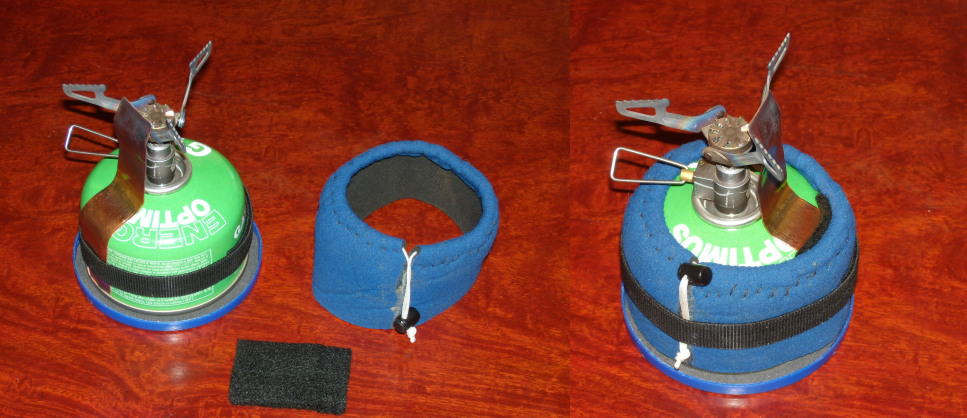Introduction
The purpose of this article is to present to the reader several different methods that can be employed to keep fuel warm during canister stove operation in sub freezing temperatures.
I will first offer some basic information about canister fuel which might be of interest to those that are somewhat inexperienced in its use.
The Fuels
The commonly available fuel canisters used for camping and backpacking contain some combination of three fuels – propane, iso-butane, and n-butane. These have somewhat different physical properties, but they all yield about the same amount of BTUs (heat) when they burn. These gases are compressed into their (mostly) liquid form when inside the canister, and when the stove valve is opened the vaporized form of the gas is allowed to escape the canister. We ignite this gas and start boiling our water or cook our food.
Recent experiences suggest that an increasing number of canister brands also contain higher order hydrocarbons, heading into the wax category, and some fine dust or dirt. the amount of ‘refining’ being done seems to be falling, especially in China.
The main difference among the three gases is the temperature at which the liquid vaporizes into the gaseous state, which is required for us to burn it. The following is a list of the three gases and the vaporization temperature of each at sea level:
| Propane | -44 F (-42 C) |
| Iso-butane | +11 F (-12 C) |
| n-Butane | +31 F (-0.56 C) |
As you can see, n-butane is rather useless in below-freezing temperatures as it won’t vaporize. For this reason I find it important to not use any fuel that contains n-butane. In summer it is fine, but not in winter. We want as much propane in the canister as possible, with the rest being iso-butane. There is another fact to be aware of – these vaporization temperatures become lower as one goes up in altitude as the reduced atmospheric pressure allows the gases to vaporize more readily. For example, iso-butane vaporizes at +2.3 F (-16.5 C) at an elevation of 5400′ (2,550 m).
Also, there is something else to consider. When the fuel ‘boils’ from the liquid state to become a gas, it robs heat from the canister. This is called the latent heat of vaporization, and the heat loss happens automatically. So the canister cools itself when the stove is in use, and it will become colder than the ambient temperature.
We can now see that there are two conditions which we must overcome – the ambient temperature, and the self-cooling of the canister. There are numerous ways we can accomplish this.
WARNING!
Overheating a fuel canister can have dire consequences, including serious injury, death, and forest fires. The U.S. DOT requires that these fuel canisters be safe to be transported at temperatures of up to 50 C (+122 F). In common field use, if a canister is too hot for you to comfortably touch (over +104 F or +40 C), it must be cooled down immediately. This is known as the ‘touch test’. See our article on Exploding Gas Canisters for more details. You are on your own to assure that you don’t overheat a canister and cause it to explode.
Techniques for Warming
The following is a list of various techniques that have proven to be effective in warming a fuel canister. Some are superior to others, and this will be discussed as I describe each technique individually. Keep in mind that warming a canister is usually not necessary at ambient temperatures comfortably above freezing.
- Carry the canister during the day in your pack near your back.
- Store the canister in a warm coat pocket, or sleep with it at night.
- If you have a campfire, place the canister and stove close (but not too close) to the fire.
- Warm the bottom of the canister with a small butane lighter; a candle will work as well.
- Use a water bath.
- Place a hand warmer under the canister.
- Employ an IR reflector screen.
- Employ a 3/4 windscreen.
- Employ a copper heat exchanger strip or wire.
- Use a remote inverted canister stove.
We will look at each of these in some detail. But whatever you do, remember the touch test.
Member Exclusive
A Premium or Unlimited Membership* is required to view the rest of this article.
* A Basic Membership is required to view Member Q&A events




Home › Forums › How to Keep Fuel Warm During Canister Stove Operation